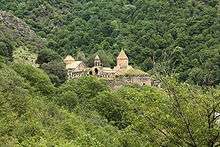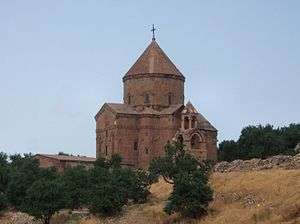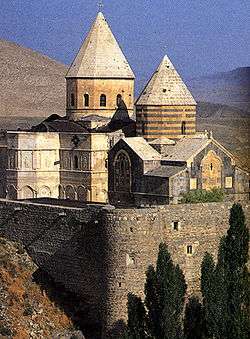Dadivank
| Dadivank Դադիվանք | |
|---|---|
 The monastery of Dadivank | |
 Shown within Nagorno-Karabakh Republic | |
| Basic information | |
| Location |
|
| Geographic coordinates | 40°09′41″N 46°17′17″E / 40.161391°N 46.288013°ECoordinates: 40°09′41″N 46°17′17″E / 40.161391°N 46.288013°E |
| Affiliation | Armenian Apostolic Church |
| Architectural description | |
| Architect(s) | yes |
| Architectural type | Monastery, Church |
| Architectural style | Armenian |
| Completed | 9th–13th centuries |
Dadivank (Armenian: Դադիվանք) also Khutavank (Armenian: Խութավանք – Arm. Monastery on the Hill[1]) is an Armenian monastery in the Shahumian Region of the Nagorno-Karabakh Republic, de jure Kalbajar District in Azerbaijan. It was built between the 9th and 13th century.
History and architecture
The monastery was founded by St. Dadi, a disciple of Thaddeus the Apostle who spread Christianity in Eastern Armenia during the first century AD. However, The monastery was first mentioned in the 9th century. In June, 2007, the grave of St. Dadi was discovered under the holy altar of the main church.[2] The princes of Upper Khachen are also buried at Dadivank, under the church's gavit.[3]
The Monastery belongs to the Artsakh Diocese of the Armenian Apostolic Church, and consists of the Cathedral church of St. Astvadzadzin, the chapel and a few other buildings. The main church has Armenian script engraved into its walls, in addition to several 13th century frescoes.[4] The bas-relief on the south facade of the cathedral at Dadivank, built in 1214, shows the princess offering the church in memory of her sons.[5] According to Paolo Cuneo, Dadivank is one of two Monasteries along with Gandzasar where bust motifs (possiblly the donors of the monasteries) can be found.[6]
On 8 October 2001, Document No 9256 on the maintenance of historical and cultural heritage in the Nagorno-Karabakh Republic was signed by 16 members of the Parliamentary Assembly of the Council of Europe from Armenia, Cyprus, Italy, Romania, Greece and Russia In which they stated that one of Azerbaijan's policies in Nagorno-Karabakh was the destruction of Dadivank, which "the local Muslim population regarded as remnants of the Armenian Christian religion and ruined the monastery as it could".[7][8] In 1994 the monastery was reopened and the reconstruction process began in 2004 with funding from Armenian-American businesswoman Edele Hovnanian, ending in 2005. The restoration efforts restored the Cathedral, along with a chapel which was restored by Edik Abrahamian, an Armenian from Tehran, Iran.[9]
Gallery
 Dadivank
Dadivank.jpg) General view
General view Side view
Side view Khachkars at Dadivank
Khachkars at Dadivank
See also
| Wikimedia Commons has media related to Dadivank Monastery. |
Books
- (in French) Le Petit Futé Arménie – by Dominique Auzias, Jean-Paul Labourdette – 2009 – 330 pages
- Armenologie in Deutschland, by Armenuhi Drost-Abgarjan, Hermann Goltz – 2005 – p. 59
- (in Italian) Documenti di architettura armena, Alexandr L. Jakobson – 1986 – 73 p.
References
- ↑ Жеан-Паул Лабурдетьте, Доминикуе Аузиас, Армения, Petit Futé, 2007 – p. 203
- ↑ В старинном монастыре Нагорного Карабаха обнаружены мощи одного из учеников Иисуса Христа
- ↑ Georgia, Armenia and Azerbaijan, by John Noble, Michael Kohn, Danielle Systermans, Lonely Planet, 2008 – 364 pages, p. 307
- ↑ Lydia А. Durnovo, Essays on the Fine Arts of Medieval Armenia. Moscow. 1979.[In Russian]
- ↑ Treasures from the ark: 1700 years of Armenian Christian art, by Vrej Nersessian, British Library, 2001 – 240 pages
- ↑ Paolo Cuneo, Architettura Armena, Roma, 1988, pp. 450, 761, cited by. ALPAGHIAN: Raccolta di scritti in onore di Adriano Alpago Novello, Italy, 2005
- ↑ Iskander Haji "Lel-Kala – A near and unavailable fortress, Vishka, No. 10, 16–23 March 2000
- ↑ Parliamentary Assembly Documents 2002 Ordinary Session (First Part) , Volume I, Council of Europe, p. 35
- ↑ RESTORATION IN DADIVANK
External links
- Dadivank Monastery
- Dadivank Gallery
- Recent Historical-Architectural Research on Dadivank
- Gandzasar.com: Pilgrimage and Tourism, Nagorno Karabakh Republic
- Dadivank Monastery at wikimapia.org
- Program about Dadi Monastery by Vem Radio


